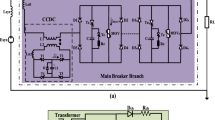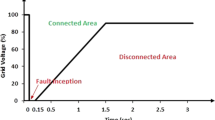Abstract
Series-Compensated Transmission Lines (SCTLs) are widely used for connection of large scale wind power plants (WPPs) to the power system to transmit the active power generated from WPPs. However, it can lead to sub synchronous resonance (SSR) phenomena in WPPs connected with SCTLs. Also, capacitive compensation of transmission lines reduces the line impedance, which leads to increasing short circuit current level in WPPs. This study proposes the resistive bridge-type fault current limiter (RBFCL) for SSR mitigation and limiting short circuit current in WPPs connected with SCTLs. Also, its performance is compared with the static synchronous compensator (STATCOM) and thyristor controlled series capacitor (TCSC) to demonstrate the effectiveness of the RBFCL in terms of SSR mitigation. The WPP used in this paper is modelled based on an aggregated squirrel-cage induction generator (SCIG) derived by an aggregated wind turbine (WT). The PSCAD/EMTDC software and the IEEE first benchmark model are used for this study. Simulation results demonstrate that the RBFCL not only limits the short circuit current contribution of WPPs, but also effectively damps the SSR oscillations due to IGE as well as TI, when the WPP is subjected to a large disturbance.














Similar content being viewed by others
References
Tsili M, Papathanassiou S (2009) A review of grid code technical requirements for wind farms. IET Renew Power Gener 3(3):308–332
Moharana A, Varma RK (2011) Subsynchronous resonance in single-cage self-excited-induction-generator-based wind farm connected to series-compensated lines. IET Gener Transm Distrib 5(12):1221–1232
Mani DR, Periasamy S (2020) Sub-synchronous resonance constrained OPF using reconciled pack dominance based grey wolf optimisation. J Electr Eng Technol. https://doi.org/10.1007/s42835-020-00478-7
Xie X, Zhang X, Liu H, Liu H, Li Y, Zhang C (2017) Characteristic analysis of subsynchronous resonance in practical wind farms connected to series-compensated transmissions. IEEE Trans Energy Convers 32(3):1117–1126
Alawasa KM, Mohamed YA (2015) A simple approach to damp SSR in series-compensated systems via reshaping the output admittance of a nearby VSC-based system. IEEE Trans Ind Electron 62(5):2673–2682
Varma RK, Auddy S, Semsedini Y (2006) Mitigation of subsynchronous resonance in a series-compensated wind farm using static var compensator. Power Eng Soc Gen Meet 2006 IEEE 27:1–7
. Boopathi R, Muzamil A, Kumudini RP (2014) Analysis and mitigation of subsynchronous oscillations in a radially-connected wind farm. In: 2014 power energy system conference towar sustain energy, PESTSE, pp 1–7
Mohammadpour HA, Islam MM, Santi E, Shin YJ (2016) SSR damping in fixed-speed wind farms using series FACTS controllers. IEEE Trans Power Deliv 31(1):76–86
Mohammadpour HA, Santi E (2015) Optimal adaptive sub-synchronous resonance damping controller for a series-compensated doubly-fed induction generator-based wind farm. IET Renew Power Gener 9(6):669–681
Varma R, Auddy S (2008) Mitigation of subsynchronous resonance in a series-compensated wind farm using FACTS controllers. IEEE Trans Power Deliv 23(3):1645–1654
Moharana A, Varma RK, Seethapathy R (2014) SSR alleviation by STATCOM in induction-generator-based wind farm connected to series compensated line. IEEE Trans Sustain Energy 5(3):947–957
Golshannavaz S, Mokhtari M, Nazarpour D (2011) SSR suppression via STATCOM in series compensated wind farm integrations. In: 2011 19th Iranian conference on electrical engineering, pp 1–6
Rashad AM, Kamel S (2016) Enhancement of hybrid wind farm performance using tuned SSSC based on Multi-Objective Genetic Algorithm. In: 2016 eighteenth international middle east power systems conference (MEPCON), pp 786–791
Golshannavaz S, Aminifar F, Nazarpour D (2014) Application of UPFC to enhancing oscillatory response of series-compensated wind farm integrations. IEEE Trans Smart Grid 5(4):1961–1968
Lyu J, Cai X, Amin M, Molinas M (2018) Sub-synchronous oscillation mechanism and its suppression in MMC-based HVDC connected wind farms. IET Gener Transm Distrib 12(4):1021–1029
Chi Y, Tang B, Hu J, Tian X, Tang H, Li Y, Sun S, Shi L, Shuai L (2019) Overview of mechanism and mitigation measures on multi-frequency oscillation caused by large-scale integration of wind power. CSEE J Power Energy Syst 5(4):433–443
Irwin GD, Jindal AK, Isaacs AL (2011) Sub-synchronous control interactions between Type3 wind turbines and series compensated AC transmission system. In: IEEE power energy society general meeting. 2011, pp 1–6. https://doi.org/10.1109/PES.2011.6039426
Bongiorno M, Petersson A, Agneholmat E (2011) The impact of wind farms on subsynchronous resonance in power systems. Elforsk technical report, http://docshare01.docshare.tips/files/18627/186273948.pdf
Firouzi M, Gharehpetian GB, Mozafari B (2017) Power flow control and short circuit current limitation of wind farms using unified inter-phase power controller. IEEE Trans Power Deliv 32(1):871–882
Safaei A, Zolfaghari M, Gilvanejad M, Gharehpetian GB (2020) A survey on fault current limiters: development and technical aspects. Int J Electric Power Energy Syst 118:105729
Okedu KE, Muyeen SM, Takahashi R, Tamura J (2016) Conceptual design and evaluation of a resistive-type SFCL for efficient fault ride through in a DFIG. IEEE Trans Appl Superconduct 26(1):105729
Firouzi M, Aslani S, Gharehpetian GB, Jalilvand A (2012) Effect of superconducting fault current limiters on successful interruption of circuit breakers. In: IEEE international conference on renewable energies and power quality (ICREPQ 2012)
Salami Y (2011) Dynamic performance of wind farms with bridge-type superconducting fault current limiter in distribution grid. In: Proceedings of 2nd international conference on electrical power energy conversion system, 2011, pp 1–6
Firouzi M, Gharehpetian GB (2013) Improving fault ride-through capability of fixed-speed wind turbine by using bridge-type fault current limiter. IEEE Trans Energy Convers 28(2):361–369
Rashid G, Ali MH (2017) Fault ride through capability improvement of DFIG based wind farm by fuzzy logic controlled parallel resonance fault current limiter. Electric Power Syst Res 146:1–8
Firouzi M (2018) A modified capacitive bridge-type fault current limiter (CBFCL) for LVRT performance enhancement of wind power plants. Int Trans Electric Energy Syst 28(3):2505
Rashid G, Hasan Ali M (2014) Bridge-type fault current limiter for asymmetric fault ride-through capacity enhancement of doubly fed induction machine based wind generator. In: Proceedings of IEEE energy conversion congress on expo., pp 1903–1910
Firouzi M, Gharehpetian GB (2018) LVRT performance enhancement of DFIG-based wind farms by capacitive bridge-type fault current limiter. IEEE Trans Sustain 9(3):1118–1125
Kartijkolaie HS, Radmehr M (2018) LVRT capability enhancement of DFIG-based wind farms by using capacitive DC reactor-type fault current limiter. Int J Electric Power Energy Syst 102:287–295
Firouzi M, Gharehpetian GB, Mozafari SB (2017) Application of UIPC to improve power system stability and LVRT capability of SCIG-based wind farms. IET Gener Transm Distrib 11(9):2314–2322
Firouzi M, Gharehpetian GB, Mozafari B (2015) Improvement of power system stability by using new switching technique in bridge-type fault current limiter. Electric Power Compon Syst 43(2):234–244
Firouzi M, Gharehpetian GB, Pishvaei M (2013) THD reduction of PCC voltage by using bridge-type fault current limiter. Int Trans Electric Energy Syst 23(5):655–668
Hossain ME (2018) Improvement of transient stability of DFIG based wind generator by using of resistive solid state fault current limiter. Ain Shams Eng J 9(4):2557–2570
Rashid G, Ali MH (2015) Transient stability enhancement of double fed induction machine based wind generator by bridge-type fault current limiter. IEEE Trans Energy Convers 30(3):937–947
Anderson PM, Bose A (1983) Stability simulation of wind turbine systems. IEEE Trans Power Appar Syst 102(12):3791–3795
Author information
Authors and Affiliations
Corresponding author
Additional information
Publisher's Note
Springer Nature remains neutral with regard to jurisdictional claims in published maps and institutional affiliations.
Rights and permissions
About this article
Cite this article
Emami, Y., Koochaki, A. & Radmehr, M. SSR Alleviation in SCIG-Based Wind Power Plants Using Resistive Bridge-Type FCL. J. Electr. Eng. Technol. 16, 907–916 (2021). https://doi.org/10.1007/s42835-020-00638-9
Received:
Revised:
Accepted:
Published:
Issue Date:
DOI: https://doi.org/10.1007/s42835-020-00638-9




